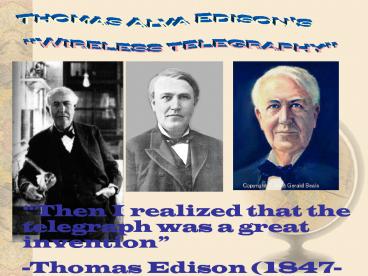Thomas Alva Edison's - PowerPoint PPT Presentation
Title:
Thomas Alva Edison's
Description:
Then I realized that the telegraph was a great invention -Thomas Edison (1847-1931)-Introduction The general backgrounds and works of Edison Edison s invention ... – PowerPoint PPT presentation
Number of Views:287
Avg rating:3.0/5.0
Title: Thomas Alva Edison's
1
Thomas Alva Edison's "Wireless telegraphy"
Then I realized that the telegraph was a great
invention -Thomas Edison (1847-1931)-
2
"The Complex Interrelation between Science and
Technology in a Contextual Historical
Interpretation of Edison's Invention"
- Introduction
- The general backgrounds and works of Edison
- Edisons invention of wireless telegraphy
- Critical Reflections/ Historical Interpretations
- Conclusion
3
I.Introduction
- Leading Questions
- 1. Is it important to be aware of the
interrelation between science and technology?
Why? - 2. How did the relation between science and
technology appear in the works of Edison? - Method of Analysis critical-historical
interpretation
4
- Literatures (primary and secondary sources)
- - Russel, Collin A. Approaches to the History
of Science. - - Otto, Mary. The Science and Technology
Relationship. - - Dyer, Lewis Frank et al.,EdisonHis Life
Inventions, vol.2. - - Crowther, J.G. Famous American Men of Science
(II). - - Cowan, Ruth Schwartz. A Social History of
American Technology. - - Kline, Ronald. Construing Technology as
Applied Science. - - Popper, K.R. Objective Knowledge.
5
II.The General Backgrounds Works of Edison
- His Life
- -born in 1847
- -died in 1931
- Educational Background
- -never completed school/ self-study/ no formal
academic background - His Works
- -1857 started chemical lab
- -1859 editor
- -1860 telegraph operator
- -1875 started the experiment on wireless
telegraphy - -1891 his patent of wireless telegraphy
- his works come from library industrial
laboratory research
6
III.Edison's invention of "wireless telegraphy"
- General Problems--gt insufficient scientific
explanation in the utilization of electric or
ether waves in free space - How Edison invented wireless telegraphy--gt
- 1st experiment (1875) in Newark Lab..Edison
discovered a new manifestation of electricity
through sparks under conditions unknown up to
that time--gtthe discovery of the forerunner of
wireless telegraphy (oscillation)
7
continuedgt 2nd experiment (1875) further
experiment observation--gt he changed New
Force to Etheric Force
- Problem after the invention--gta controversy in
scientific community
- Impacts--gt
- - stimulating other scientists to do further
experiments and observations (Science side) - - Edison sold his patent to Marconi--gt
establishing modern wireless telegraphy of
Marconi (Technology side)
8
IV.Critical Reflection/Interpretation
- Societys opinion toward Edison (positive)
- - great inventor/ successful technologist/ Man
of Science - Dominant reasons - The principal of Utilization
- - Commercialization
- - Social Prestige
- evidences Dyer, Lewis Frank Crowther, J.G.
9
Scientific communitys opinion toward Edison
(negative) - Edison is an inventor/
technologist/ practitioner without
professional background - Scientists looked
at themselves superior than Edison
(practitioner)
--gt Q Why scientists thought negatively?--gt A
Ideology behind this interest status
- evidences Kline, Ronald Cowan, Ruth
Schwartz
10
- Our Consideration
- 1. There is an epistemological meaning in
Edisons invention. - - scientific method
- - scientific/theoretical implication
- 2. There is a complex interaction between
technologist (Edison) and society.
11
V. Conclusion
I. Professionalization of scientists and
industrial society in Edisons period (R.Kline)
12
II. Edisons case
13
III. Our attitudes 1. Edison - created the
fundamental principle of aerial telegraphy 2.
There was the complex interrelation between
society, science and technology in Edisons
case 3. In the context of STS, the complex
interrelation between science, technology, and
society that is still unclear needs to be
developed.
14
Thank You!
Presented by Mai, Mei, and Joseph (o)!!!































